Book 5 Vocabulary Unit 1 Competition 1
- 格式:docx
- 大小:13.29 KB
- 文档页数:1
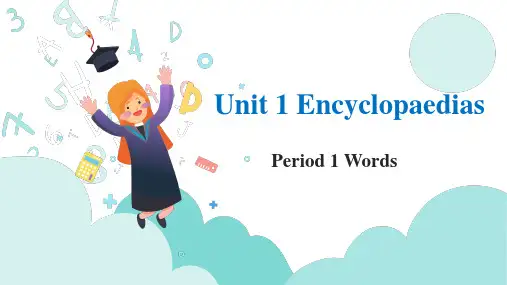
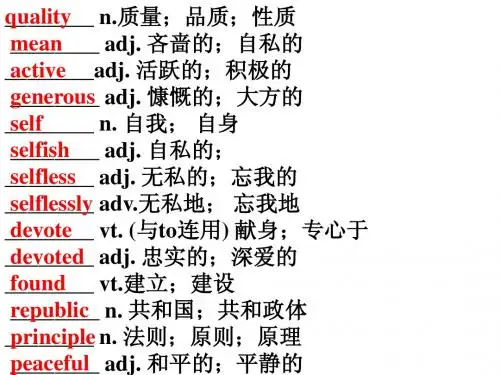

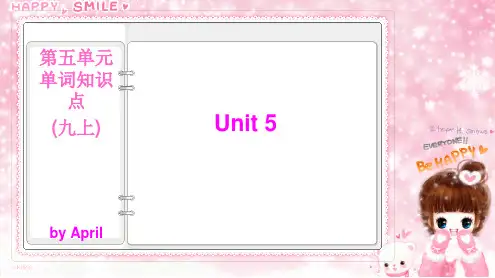
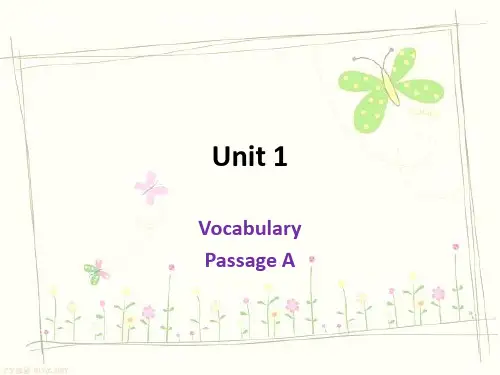
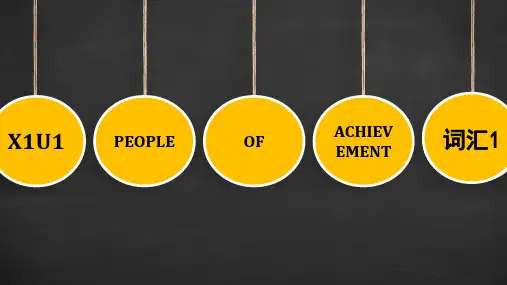
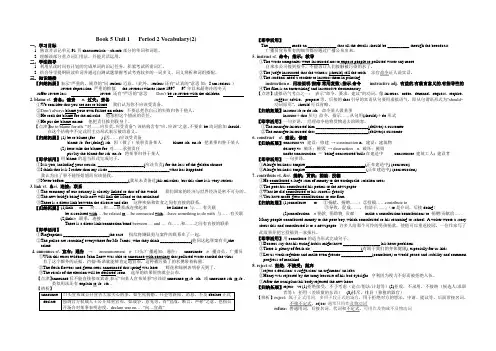
Book 5 Unit 1 Period 2 Vocabulary(2)一.学习目标1. 熟读并识记单元91页characteristic~absorb部分的单词和词组。
2. 理解该部分重点词汇用法,并能灵活运用。
二.学法指导1. 利用早读时间有计划的完成单词的识记任务,积累考试所需词汇。
2. 结合导学提纲研读单词并通过自测试题掌握考试考查较多的一词多义、词义辨析和词组搭配。
三.知识链接【归纳拓展】表示“严重的,剧烈的”同serious近意。
(此外,serious还有“认真的”意思.如:I am serious.)severe depression 严重的抑郁the severest winter since 1997 97年以来最寒冷的冬天suffer severe loss severe 还有“严厉的”意思Don’t be so severe with the children.2. blame vt. 责备;谴责n. 过失;责备①We consider that you are not to blame. 我们认为你不应该受责备。
②Don’t always blame your own failure on others. 不要总把你自己的失败归咎于他人。
③He took the blame for the mistake. 他承担这个错误的责任。
④He put the blame on me. 他把责任推到我身上。
【点津】be to blame for sth. “对……应负责,应受责备”;该结构含有“应,应该”之意,不要在be动词前加should。
在这个结构中不定式用主动形式表示被动意义。
【归纳拓展】(1) be to blame (for. . . ) (因……)应该受责备blame sb. for (doing) sth. 因(做了)某事责备某人blame sth. on sb. 把某事归咎于某人(2) bear/take the blame for 对……承担责任put/lay the blame for sth. on sb. 将某事归咎于某人【即学活用】用blame的适当形式完成句子。
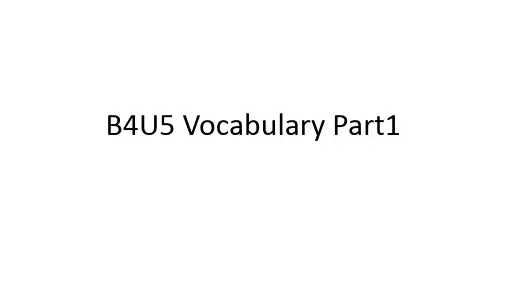
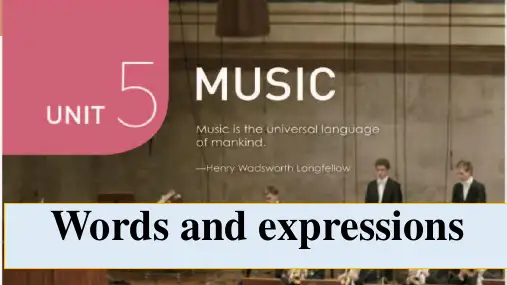
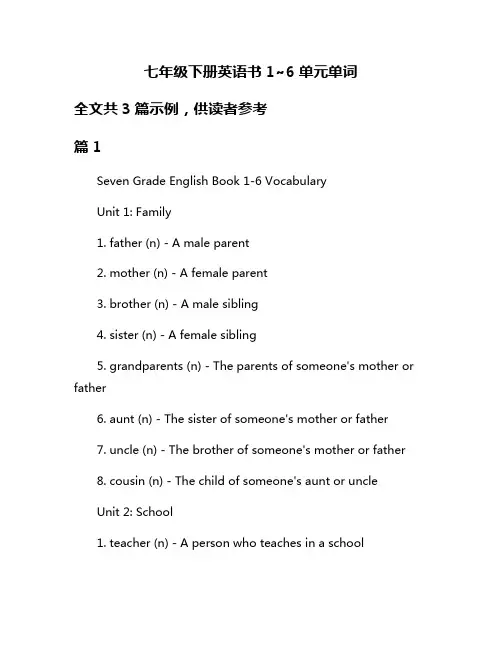
七年级下册英语书1~6单元单词全文共3篇示例,供读者参考篇1Seven Grade English Book 1-6 VocabularyUnit 1: Family1. father (n) - A male parent2. mother (n) - A female parent3. brother (n) - A male sibling4. sister (n) - A female sibling5. grandparents (n) - The parents of someone's mother or father6. aunt (n) - The sister of someone's mother or father7. uncle (n) - The brother of someone's mother or father8. cousin (n) - The child of someone's aunt or uncleUnit 2: School1. teacher (n) - A person who teaches in a school2. student (n) - A person who is studying at a school or college3. classroom (n) - A room in a school where students are taught4. desk (n) - A piece of furniture with a flat top and one or more legs5. pen (n) - An instrument for writing or drawing6. pencil (n) - A thin instrument for writing or drawing7. book (n) - A written or printed work consisting of pages glued or sewn together along one side8. ruler (n) - An instrument used for drawing straight lines or measuring lengthsUnit 3: Food1. breakfast (n) - The first meal of the day2. lunch (n) - A meal eaten in the middle of the day3. dinner (n) - The main meal of the day4. snacks (n) - Small amounts of food eaten between meals5. fruit (n) - The sweet and fleshy product of a tree or other plant that contains seeds6. vegetables (n) - Plants grown for their edible parts, such as roots, stems, leaves, or flowers7. meat (n) - The flesh of an animal used as food8. fish (n) - A limbless cold-blooded vertebrate animal with gills and fins living wholly in waterUnit 4: Animals1. dog (n) - A domesticated carnivorous mammal2. cat (n) - A small domesticated carnivorous mammal3. bird (n) - A warm-blooded egg-laying vertebrate animal with feathers4. fish (n) - A limbless cold-blooded vertebrate animal with gills and fins living wholly in water5. rabbit (n) - A small furry animal with long ears6. turtle (n) - A slow-moving reptile with a protective shell7. horse (n) - A large mammal with hooves used for riding and racing8. elephant (n) - A huge mammal with a long trunk and tusksUnit 5: Hobbies1. read (v) - To look at and comprehend written or printed matter2. write (v) - To form letters or words on a surface with an instrument3. draw (v) - To produce a picture or diagram by making lines and marks on paper4. sing (v) - To make musical sounds with the voice5. dance (v) - To move rhythmically to music6. play (v) - To engage in recreation or amusement7. paint (v) - To make a picture with color on a surface8. cook (v) - To prepare food by heating itUnit 6: Travel1. plane (n) - A fixed-wing aircraft that is propelled forward by the thrust of a jet engine or a propeller2. train (n) - A connected series of railroad cars pushed or pulled by a locomotive3. bus (n) - A large motor vehicle carrying passengers by road4. car (n) - A four-wheeled motor vehicle used for transportation5. bicycle (n) - A vehicle consisting of two wheels held in a frame with pedals for propulsion6. boat (n) - A small vessel for transportation on water7. ship (n) - A larger vessel for transportation on water8. hike (v) - To walk a long distance, especially in the countrysideIn conclusion, these are some of the key vocabulary words from the seven grade English book for units 1-6. Mastering these words will help improve your English skills and knowledge. Keep practicing and expanding your vocabulary to become a proficient English speaker.篇2Title: Vocabulary List from Grade 7 Book 1-6 UnitsIn the seventh grade English curriculum, students are introduced to a wide range of vocabulary words to expand their language skills and comprehension. Here is a comprehensive list of vocabulary words from Units 1 to 6 in the seventh-grade English book:Unit 11. achieve2. ambition3. concept4. encourage5. enhance6. express7. fortunate8. identity9. impact10. numerous Unit 21. adapt2. analyze3. challenge4. decrease5. effective7. issue8. participate9. potential10. solution Unit 31. appreciate2. circumstance3. consequence4. determine5. efficient6. individual7. motivate8. perspective9. recognize10. variety Unit 42. benefit3. contribute4. culture5. influence6. involve7. prevent8. respond9. support10. tradition Unit 51. comprehend2. conclude3. demonstrate4. evaluate5. interpret6. notice8. predict9. summarize10. visualizeUnit 61. acquire2. appropriate3. collaborate4. interact5. investigate6. reflect7. relevant8. require9. source10. transferThese vocabulary words are essential for students to understand and apply in various contexts, both in their English studies and in their everyday lives. By mastering these words,students will be able to communicate more effectively and comprehend complex texts more easily.In conclusion, the vocabulary words from Units 1 to 6 in the seventh-grade English book provide a solid foundation for students to build upon as they continue their language learning journey. It is important for students to review and practice these words regularly to solidify their understanding and mastery of the English language.篇3Unit 1:1. ability2. adventure3. awesome4. be able to5. bike6. classmate7. colorful8. clever9. communicate 10. concert 11. designer 12. drawing 13. festival 14. fun 15. funnyUnit 2:1. It's time to do sth2. each other3. band4. city5. festival6. get together7. movie8. rock9. roller coaster 10. sing along 11. skateboard 12. team 13. violin 14. play basketball 15. meet upUnit 3:1. age2. artist3. at least4. competition5. France6. Italy7. picnic8. sports9. spelling 10. coach 11. a lot of 12. outdoor 13. are good at 14. Asia 15. relaxUnit 4:1. besides2. benefit3. develop4. exercise5. join6. kick7. roller-skate8. spend9. spring 10. any 11. gym 12. regular 13. too much 14. for fun 15. createUnit 5:1. aim2. club3. company4. both5. competition6. noise7. volleyball8. skiing9. swimming 10. tennis 11. action 12. activity 13. fan 14. by oneself 15. join usUnit 6:1. one more2. study for3. Best wishes4. suddenly5. cloud6. grow7. hill8. countryside9. be afraid of 10. snake 11. hit 12. woods 13. scream 14. drop 15. get lostThese are the vocabulary words for Units 1 to 6 in the seventh-grade English book. Students can use these words for their study or practicing conversations with family and friends. Learning and using these words will help improve their English language skills and expand their vocabulary.。
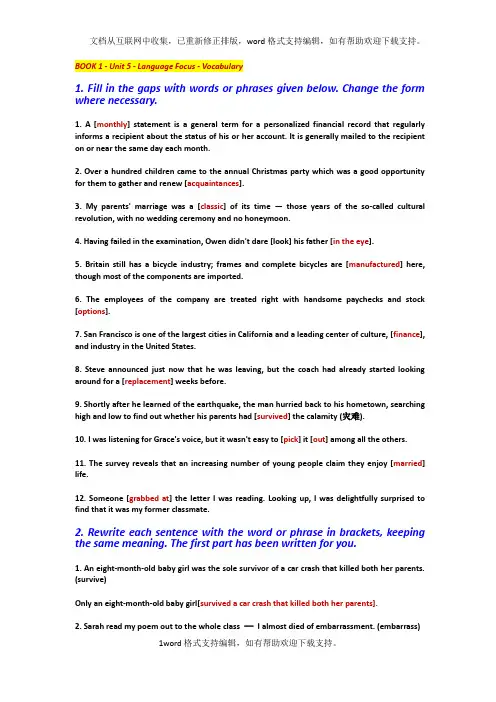
BOOK 1 - Unit 5 - Language Focus - Vocabulary1. Fill in the gaps with words or phrases given below. Change the form where necessary.1. A [monthly] statement is a general term for a personalized financial record that regularly informs a recipient about the status of his or her account. It is generally mailed to the recipient on or near the same day each month.2. Over a hundred children came to the annual Christmas party which was a good opportunity for them to gather and renew [acquaintances].3. My parents' marriage was a [classic] of its time —those years of the so-called cultural revolution, with no wedding ceremony and no honeymoon.4. Having failed in the examination, Owen didn't dare [look] his father [in the eye].5. Britain still has a bicycle industry; frames and complete bicycles are [manufactured] here, though most of the components are imported.6. The employees of the company are treated right with handsome paychecks and stock [options].7. San Francisco is one of the largest cities in California and a leading center of culture, [finance], and industry in the United States.8. Steve announced just now that he was leaving, but the coach had already started looking around for a [replacement] weeks before.9. Shortly after he learned of the earthquake, the man hurried back to his hometown, searching high and low to find out whether his parents had [survived] the calamity (灾难).10. I was listening for Grace's voice, but it wasn't easy to [pick] it [out] among all the others.11. The survey reveals that an increasing number of young people claim they enjoy [married] life.12. Someone [grabbed at] the letter I was reading. Looking up, I was delightfully surprised to find that it was my former classmate.2. Rewrite each sentence with the word or phrase in brackets, keeping the same meaning. The first part has been written for you.1. An eight-month-old baby girl was the sole survivor of a car crash that killed both her parents. (survive)Only an eight-month-old baby girl[survived a car crash that killed both her parents].2. Sarah read my poem out to the whole class ─I almost died of embarrassment. (embarrass)I was[almost embarrassed to death when Sarah read my poem out to the whole class].3. The seriously injured pupils will be under the care of doctors and nurses of the Children's Hospital. (care for)Doctors and nurses[of the Children's Hospital will care for the seriously injured pupils].4. Several people have phoned the personnel department to inquire about the position of Chief Financial Officer. (inquiry)The personnel department has received[several phone calls making inquiries about the position of Chief Financial Officer].5. We can help you find a solution to all your financial problems if you join our club. (straighten out)We can help you[straighten out all your financial problems if you join our club].plete the following, using the words or phrases in brackets. Make additions or changes where necessary.1. On further [inquiry], we learned that the earthquake caused heavy casualties (伤亡) and material losses to the inhabitants. Many old people [died of hunger] and thirst after they were trapped for nearly a week. Fortunately most younger [people survived]. (die of, survive, inquiry)2. [Instantly] the news spread among employees of the firm that David had decided to [give up his] current position and [retire]. Thereupon everyone became curious about who would [replace him] as chief [executive] officer. (retire, executive, replace, instantly, give up)3. Brown used to live on his parents. However after [his beloved] father died he had to support himself economically. He did a lot of [odd jobs], including shining shoes, washing dishes, [and all that]. (and all that, beloved, odd)Word FormationA suffix is a letter or group of letters added to the end of a word to form a new one. Unlike prefixes, a suffix frequently alters the part of speech of the word. For example, the verb replace, by the addition of the suffix -ment, is changed into a noun replacement.Complete the following sentences by adding a suffix to the given base in brackets.1. He looked down at the floor in an attempt to hide his [embarrassment]. (embarrass)2. Rescue workers continued to search for [survivors], nearly 72 hours after the collapse of the World Trade Center. (survive)3. A tiny old lady was among a group looking at an art exhibition in a [newly] opened gallery. (new)4. The reality is that we all have [marketable] skills such as writing, consulting, or designing and selling things. (market)5. Many people are now having trouble making their [monthly] house payments (month)6. A spelling bee is a [competition] in which people try to correctly spell words. (compete)7. The total energy given off by the devastating earthquake was many times more than any [conceivable] chemical reaction could produce. (conceive)8. It shocked me to learn that the young man was released simply because he came from a [respectable] middle-class family. (respect)UsageRewrite the parts in italics with "the + adj.".1. Some Democrats believed they lost the election because poor people didn't turn out to vote. [the poor]2. Those who had died were completely innocent victims of the bomb. [The deceased / The dead]3. The governor has guaranteed health care for pregnant women, preschool children, and disabled people. [the disabled]4. Do you know why French people are skinnier than Americans? It is because French people stop when they're full, Americans stop when the plate is empty (or the TV show ends). [the French]5. The person who was accused denied stealing his student's ideas and publishing them. [The accused]6. In our city living together without getting married is not common among young people. [the young]7. People who are not employed will receive a monthly payment from the local government. [The unemployed]8. Where unemployment and crime are high, it can be assumed that crime is due to unemployment.[the latter ... the formerCloze1. Complete the following passage with words chosen from the Words and Phrases to Drill box. Change the form where necessary.I hear poor Phil has [died of] (1) a heart attack. Died [instantly] (2), I believe. Mind you, if you were looking for a heart attack victim, he was a [classic] (3) case. You need only [askaround] (4) to hear everyone say that he worked all hours, never taking a break. That sort of person all too often risks not [surviving] (5) long enough to [retire] (6) on a pension. No doubt the chief [executive] (7) is already looking around for Phil's [replacement] (8). I know you can't afford to be sentimental in business, not with [stock] (9) holders breathing down your neck all the time. Still, he must have found it difficult to look Phil's widow [in the eye] (10) at the funeral after allowing him to overwork like that.2. Read the following passage carefully until you have got its main idea, and then select one appropriate word for each gap from the box.One summer evening, shortly after I arrived at my new assignment, my boss walked by my house and saw my wife and children sitting on our front porch. He asked her where I was. My wife told him I was still at the office. When she told this to me, in the corner of my heart I secretly hoped he was [impressed] (1) by my work ethic (职业道德).The next morning, my boss called me. I expected a verbal pat on the back for my [diligence] (2) and hard work. [Instead] (3), he asked me what I was doing so late at the office and inquired if I had been doing that every night since taking over. I told him I had indeed been working late every night.[Contrary](4) to what I expected, he told me anyone could be a workaholic and achieve great things [professionally] (5). Yet he had hired me to [perform] (6) and excel (干得出色) in not one but two areas: my professional and personal life.This incident caused me to do a lot of introspection (沉思). I examined my professional, family and[personal] (7) life and found that they weren't in [balance] (8). So I made a [commitment] (9) to myself to work on achieving a better balance in these three areas. This is what my little voyage of self-discovery [revealed] (10) to me.3. Translate the following sentences into English, using the words or phrases in brackets.1. 我不太清楚哪儿你能找到个好木工(carpenter)——你最好四处打听打听。
七年级下册人教版英语书第五单元单词表全文共3篇示例,供读者参考篇1Unit 5 in the seventh grade textbook of People's Education Edition includes a rich vocabulary list that students need to master in order to improve their English language skills. In this unit, students will learn new words related to different topics such as sports, hobbies, musical instruments, and more. Below is the vocabulary list for Unit 5:1. Activity2. Art3. Baseball4. Basketball5. Chess6. Draw7. Game8. Hobby9. Instrument10. Listen11. Music12. Painting13. Piano14. Play15. Puzzle16. Skateboard17. Soccer18. Song19. Tennis20. ViolinThese words are essential for students to fully understand the lessons and activities in Unit 5. To help students memorize and practice these words, teachers can incorporate various vocabulary-building exercises and games into their lessons. For example, teachers can create flashcards with the words on one side and the definitions on the other side, then quiz students on their knowledge. In addition, teachers can also organizevocabulary quizzes, spelling bees, and group activities to reinforce the learning of these words.Furthermore, students can also practice using these words in their daily conversations or writing exercises. Encouraging students to use the vocabulary in context will help them retain the words better and improve their overall language skills. By mastering the vocabulary in Unit 5, students will be able to communicate more effectively in English and expand their knowledge of different topics.篇2Unit 5 of the seventh grade textbook of People's Education Press introduces a variety of new vocabulary words and phrases for students to learn and practice. These words cover a wide range of topics, including family members, daily routines, hobbies, and expressing preferences. By mastering these words, students will be able to improve their English language skills and have a better understanding of the world around them.Here is a list of the vocabulary words and phrases introduced in Unit 5:1. Family Members:- father- mother- brother- sister- grandfather- grandmother - uncle- aunt- cousin2. Daily Routines: - wake up- brush teeth- wash face- have breakfast - go to school- have lunch- do homework - go to bed3. Hobbies:- play basketball- read books- listen to music- watch movies- draw pictures- sing songs- dance- play chess4. Expressing Preferences: - like- love- enjoy- prefer- dislike- hateIn addition to the vocabulary words, Unit 5 also includes exercises and activities to help students practice using the words in context. These exercises may involve matching words with pictures, completing sentences with the correct words, or creating dialogues using the new vocabulary.By studying and reviewing the vocabulary words in Unit 5, students will be able to expand their English language skills and communicate more effectively in a variety of situations. Mastering these words will also help students build a strong foundation for their future English language learning.In conclusion, the vocabulary words and phrases introduced in Unit 5 of the seventh grade textbook of People's Education Press are essential for students to learn and practice. By mastering these words, students will be able to communicate more effectively in English and improve their overall language skills.篇3Unit 5 Vocabulary List1. athlete - a person who is proficient in sports and other forms of physical exercise2. champion - a person who has defeated all opponents in a competition or series of competitions3. compete - to take part in a contest or competition4. compete with - to try to win against someone in a contest or game5. competition - the activity or condition of striving to gain or win something by defeating or establishing superiority over others6. competitive - having or displaying a strong desire to be more successful than others7. defeat - to win against someone in a competition or contest8. opponent - a person who competes against or fights with another in a contest, game, or argument9. physically - relating to the body as opposed to the mind10. physical fitness - the state of being physically healthy and strong11. represent - to act or speak officially for someone or something12. rival - a person or thing competing with another for the same objective or for superiority in the same field of activity13. run for - to compete as a candidate in an election14. runner-up - a competitor who finishes in second place ina race or competition15. tournament - a series of contests for determining a championThese are some of the key vocabulary words from Unit 5 in the 7th-grade People's Education Press English textbook. It is important to study and understand these words in order to effectively comprehend the unit's content and engage in activities related to sports and competition. Good luck with your studies!。
温州⼤学新视⾓研究⽣英语读说写2课习题题⽬及翻译Unit 11. His heart attack was _ _ by the physical and emotional pressures suffered under interrogation.2.We are all under the illusion that the country is doing well __ , but in fact it is in serious difficulty.3. He couldn’t join the police because he was below the _ _height allowed by the rule. 4.We hope to see stronger _ _ from the world community for international working together in the fight to protect our common natural surroundings 5. The professor felt grateful and _ _ that the debate hadn’t degenerated into something absurd and degrading6. Tiger populations have stopped _ _, and working to protect them is now a way of life in nations where they roam.7.Our efforts result in a great rise in _ _ in our universities, coupled with a radical shift in higher education from the private to the public sector 8. It was such a funny and wonderful show; I could _ _ keep from laughing with delight.9.Details are often organized according to time _ _ or from one place to another. These are two very important means of descriptive writing.10. Many how-to books advise you to _ _ into a room and impress others with your qualities. Part B 1.Even without knowing all the details, the reader can often beable to predict the general direction the author is going to. A. anticipateB. expectC. captureD. nurture2.In the Chinese household, grandparents and other relativesplay vital roles in raising children.A. intolerableB. impassionedC. intellectualD. indispensable 3.Eat these foods with plentiful Vitamin C, for example, drink orange juice with cereal (⾕类⾷品) or put a tomato on a sandwich, to increase the amount of iron absorbed. A. intensifyB. enhanceC. strengthenD. reinforce4.Believing that he was fully qualified, he submitted hisapplication instantly, but a week later he was crushed to learn that it had been turned down. A. ultimatelyB. hesitantlyC. promptlyD. attentively5. The rule for the competition is somewhat vague . I can’t get it and I require an explanation. A. distinct B. obscure C. clumsyD. imaginary6.The diseases thrive in conditions where freshwater isinsufficient and sanitation is poor. A. scarceB. plentifulC. fruitfulD. inexhaustible7.After the scandal, public confidence in the economic recoveryhas fallen dramatically, according to a post-election survey. A. graduallyB. frequentlyC. surprisinglyD. analytically8. The tutorial system is considered so important at Oxford andCambridge that students are not even forced to attend general lectures.A. compelledB. insulatedC. memorizedD. challenged9. They must know how to keep and make use of and when necessary abandon the old and outdated conventional rules.A. skimB. clarifyC. discardD. insulate10. They believe that identity theft is caused by issuing too many instant credit cards, deficient checking of identity, and too few legal protections for consumers’ personal information. A. sufficient B. overdueC. naiveD. inadequateUnit 41.The Our company is one of the leading manufacturers of commercial and kitchen equipment, such as ovens, freezers, refrigerators, blenders, etc. 2.An annual increase of 1.3% in food production is necessary at the present time to feed the human population, assuming present diets remain invariant. 3. You can the joy of your beloved ones when they receive the DVD shows made by your own hands as a special gift. 4.This book depicts the cultural history of race and the complicated relationship between and mainstream culture in early twentieth-century America. 5. These sorts of jobs are available between late May and late August and often a wide range of work.6. There is currently a trend for companies to much of their IT to third-parties, in some cases to overseas third-parties.7.In ancient China, women would compete to show off their _______ in needlecraft on Qixi, the most important way of celebrating the festival. 8.Morgan _________ publicity of any kind, and never permitted signs bearing her name at construction sites. 9. Immigrants need time to overcome difficulties when they are ___________ into new cultures.10. Electronics chain stores are sometimes willing to ________profits for a period of time in order to gain market share. Part B1. ________ leaders are those courageous individuals who throughout history have refused to accept the status quo.A. ScornfulB. VisionaryC. ImpersonalD. Respectful2. The thick soap won’t foam properly, so it is necessary and economical to ________ it with water.A. pierceB. dipC. diluteD. balance3. I’ve been on suspension for over 2 weeks because I stood up toa rude, ________ boss.A. arrogantB. disloyalC. corporateD. uncommitted4. The successful candidates are all creative in solving problems and ________ at learning new technologies and skills.A. capableB. marginalC. adequateD. adept5. She ________ as she talked about the messy young boys who had drunk up all her milk and eaten up all her chocolates.A. bristledB. disdainedC. downsizedD. shunned6. Not only does he have one of those distinctive radio voices that sets him apart, he also brings a fun and a slightly________ attitude to his show.A. irrelevantB. irreverentC. burgeoningD. mentoring7. ________ assets comprise items such as land, buildings, plants, machinery, fixtures and fittings, IT equipment and vehicles.A. DiverseB. MassiveC. ClassicalD. Tangible8. These few old-style wooden shops are soon to be demolished. With them will go the last ________ of the town’s original look.A. prowessB. monikerC. vestigeD. portfolio9. Our way to stay ahead of the competition is by continually creating ________ products and services while building new value in existing product lines.A. unmanageableB. deliverableC. innovativeD. institutional10. He always smiled and never had a negative comment about anyone or a _________ remark about any situation.A. cynicalB. skepticalC. hierarchicalD. prototypical Translation1.Having practiced for about 5 years,he is now adept at legalissues relating to international investment and trade.2.According to a survey, Gen Xers are skeptical about relying onSocial Security when they retire. They began saving for retirement early compared with their predecessors.3.All the cares and stresses of your day seem to fade away underthe relaxing and comfortable treatment of foot massage.4.Studies show that most employees place a high value on beingrecognized or being complemented for a job well done.5.Emergency rooms were clogged with patients who came fortreatment of relatively routine medical problems because they didn’t have a regular doctor.6.Anyone trying to coach or help a new technical manager makethe transition to a leadership role can get useful ideas from this book.7.Most of the time when you take a short cut for completing aproject you will end up doing some repair work later that will take double the time you saved by the short cut.8.Employees who fail to set appropriate boundaries betweentheir personal and professional lives will not be able to understand the meaning of life and work.9.The purpose of the exercise was to train staff to react in adisciplined and professional manner when in the presence of danger.10.Most Gen Xers have the desire to forgo career advancement formore time with their wife and children, especially in the early years of their children’s lives.英译汉1.然⽽,X⼀代⼈⽬睹了他们的⽗母为了职业晋升⽽做出牺牲,结果却遭遇了美国公司的⼤量裁员。
Unit 11)During the novel,there is a shift in【perspective】 from an adult ’s view of events to a child’s view.2)An examination of two fossils【reveals】 that a primitive human species had arrived in Asia from Africa about 2 million years ago.3)European Airlines【guarantees】top-quality service for its customers.4)As a 【consequence】 of being in hospital, Shelly decided that she wanted to become a nurse.5)He started out in the personnel department ; later he was【transferred】to the sales department.6)Several hundred more employees will have to be【 laid off 】 if the company does not give any new orders soon.7)Since they movedto this community they have lived in 【harmony】 with their neighbors.8)The visiting scholar spoke English with such a perfect accent that it was hard to【 identity】 his origin.9)Once the drug is approved for sale, doctors will be able to【 prescribe】it for ulcers.10)He became a millionaire overnight.Many people【envied 】 him for his good luck.11)Egypt, Israel, and the representatives of the Palestinian people will【participate】 in negotiations on the resolution of the Palestinian problem. 12)They argued against the notion that man should【dominate 】 nature rather than live in harmony with it.Unit 21.Peter says he’s seen Titanic at least20 times but I think he’ s【exaggerating 】.2.The Russian experts【postponed 】 dumping Mir in the Pacific Ocean until March .3.The increasing globalization of the electronic marketplace offersopportunities for businesses and consumers in terms of both【access 】 and choice.4.Amazingly , our soccer team won the victory in the【crucial】 final game.5.The idea of cloning【 extinct】 life forms still belongs to science fiction.6.With one year ’s observation the biologists have found how dolphins socialize ,breed,【nurture 】 their young and how they communicate.7.It ’s a bit【optimistic】 to think that we can do the journey within five hours.8.I would take you if I could but I don’t have a car at my【disposal】 thisweek.9.They are worried that the students might interpret the new regulation as a【restriction 】 of their rights.10.There is 【 abundant 】 evidence that cars have a harmful effect on theenvironment.11.Her patience with the children【diminished】as the hours went by.12.Slavery is closely 【associated】with racial prejudice , the belief thatone race is superior to another.Unit 31. The company tried to make【flexible】work arrangements so that it would make the best of all its employees.2.The company【exploited 】its workers with long hours and low pay.3.The European Union, the biggest US trade【partner】, prepared a protest to the World Trade Organization (WTO).4.If you turn the stereo up to 【maximum】 volume, the neighbors will complain.5.It's exhausting【commuting】 from Brighton to London every day.6.Professor Smith's general comments may help students to【appreciate 】 the theories in the textbook.7.He will 【accommodate】me with the use of his house while he is abroad.8.Some scientists think average global temperatures have risen due to thegreenhouse effect. Others are【skeptical】of global warming.9. I had a【breakdown】in the middle of the trip.10.It's a long-term investment, so you might expect to【incur】light lossesin the early years.11.The development of computers and other【sophisticated】 machines has made industry much more efficient.12.She inherited a【substantial】fortune from her grandmother.Unit 41. The trade of opium, a highly profitable product for British merchants andeventually a(n)【illegal】import into China, led to the Opium Wars.2. When they 【ran out 】of food, the soldiers set about hunting for more.3. Some people are complaining that car insurance【premiums】have increased toomuch this year.4. It's an old tradition in China for a man to carry his wife over the 【threshold】when they first enter their new home after getting married.5. The charity agency will recruit volunteers to build【affordable】housing for the poor.6.More 【immigrants 】were admitted to the United States for permanent residencein recent years.7.The aircraft carries 461 people【excluding】the crew and cabin staff.8. 【Credis 】earned at junior colleges could be transferred to another institution where students could complete their final years of college.9. In the article Wilmut discussed【potential】 medical uses for cloning, and ethical issues surrounding cloning technology.10. The General Assembly has exclusive authority to set the UN【budget 】, paid for by all membersaccording to an agreed quota. 11.They had to wait ten minutes for the drug to【take effect】 before they stitched up the cuts.12. I can't【figure out 】 why he quit his well-paid job to undertake such tedious work.Unit51. The landscape of the American West was【dramaticallycentury as a result of the widespread construction】altered during the 20th of dams along major rivers.2. Because of the swift, 【enormaous】growth of the urban areas many farmers left theirvillages in quest of work.3. The doctor prescribed walking as【therapy】for my weak knee.4.Some think that cloned human beings will be【deprived 】of freedom or dignityor personal identity.5.The way they treat their children【disgusts】all the neighbors.6.Amid warm【applause 】the honored guests mounted the rostrum.7.The World Health Organization (WHO) has published a report on drug abuseand 【addiction 】.8. This research has attracted wide media coverage and has【featured】 on BBCtelevision's Tomorrow World.9.I agree with him to some 【 extent 】 but there are still some areas of sharpdisagreement between us.10.The fireman 【collapsed 】from taking in too much smoke.11.【Brought up 】in the south of China, she wouldn't enjoy living in such acold climate.12.Wemust not take it for granted that the board of the directors will 【approve 】of the investment plan.Unit61. Inflation is likely to 【accelerate】this year,adding further upward pressure on interest rates.2. The famous film star felt they had【abused】her trust by talking about herto the press.3. There has been an angry reaction to the【 proposal 】to reduce government's unemployment benefits.4.As a teacher you have to 【adjust 】your methods to suit the needs of slowerchildren.5. The improvement in the job market in the past few years has been【remarkable 】.6.My grandfather has a【profound】mistrust of anything new and foreign.7.We have 【reliable 】it on evidence that there are plans to build a road here.8.Whocould have【predicted 】that within ten years he'd be in charge of the whole country ?9. The widespread use of Spanish in someAmerican cities has 【generated 】a public debate over language use in the country.10. I rang Jill and【reminded】her that the conference had been cancelled.11.Finding a cure for this disease is one of the greatest【challenges】faced by scientists.12.The teacher 【alerted】the students to the danger of swimming in the river.Unit71.The 【motivation 】for the decision is the desire to improve our service to our customers.2.Teachers will not【tolerate】cheating on exams} just as parents will not lettheir children lie and get away with it.3.A【 survey 】of the Chinese diet has revealed that a growing number of childrenin cities are overweight.4.The research has 【 confirmed 】that tobacco smoke presents a hazard to health.5.He is still one of the world's most popular tennis players, but his gameis in 【decline 】.6.It wasn't as if a fifty-year-old woman 【 posed 】 any threat to a twentyfive-year-old7.Wehave to【allow for】the possibility that we might not finish on schedule.8.We'll show you a film of the【highlights】of the competition, as there isn'ttime for the whole thing.9.The doctors have【attributed】the cause of the illness to an unknown virus.10.Tomorrow is the 【deadline 】for the students to hand in their term paper.11.Their investment turned out to be a failure and the manager was accusedof 【neglecting 】his duties.12.The proposals deserve support as they give【priority】 to the needs ofchildren.Unit81. It has been revealed that some government leaders 【abuse】their authority and positionto get illegal Profits for themselves.2.it 【turned out 】that3.The debate about whether to build the shopping centre has turned into thesensitive issue of jobs【versus】the environment.4. I'm trying to【foster】an interest in classical music in my children.5. Their faces are not【dissimilar】, I suppose you could mistake one for the other.6. With admission criteria 【ranking 】amongthe most selective in the United States,Harvard accepts less than 20 percent of all applicants.7.They Seem【content 】to socialize with a very small circle of People.8.Banks normally give 【top priority】to large businesses when deciding on loans.9.He【pulled out 】of the deal at the last moment, leaving the rest of us to makeup his share of the money.10.My judgment is that the students have spent too much time on【e xtracurricular 】activities.11.She attacked the boy because he【provoked】her into a stage of rage.12.He is a(n)【integral】part of the team and we can’t do without him.更多资料登录外语频道。